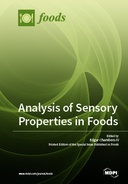Explore

Analysis of Sensory Properties in Foods
Edgar Chambers IV
2019
0 Ungluers have
Faved this Work
Login to Fave
The sensory properties of foods are the most important reason people eat the foods they eat. What those properties are and how we best measure those properties are critical to understanding food and eating behavior. Appearance, flavor, texture, and even the sounds of food can impart a desire to eat or cause us to dismiss the food as unappetizing, stale, or even inappropriate from a cultural standpoint. This Special Issue focuses on how sensory properties are measured, the specific sensory properties of various foods, and consumer behavior related to which properties might be most important in certain situations and how consumers use sensory attributes to make decisions about what they will eat. This Special Issue contains both research papers and review articles.
This book is included in DOAB.
Why read this book? Have your say.
You must be logged in to comment.
Rights Information
Are you the author or publisher of this work? If so, you can claim it as yours by registering as an Unglue.it rights holder.Downloads
This work has been downloaded 571 times via unglue.it ebook links.
- 36 - pdf (CC BY-NC-ND) at Unglue.it.
Keywords
- carryover effects
- Chicken soup
- Choquet integral
- coffee
- consumer
- consumer test
- cross-cultural affective test
- descriptive
- descriptive analysis
- descriptive sensory analysis
- emulsification
- esophageal cancer
- ethnic food
- Food
- food label
- Foods
- fruit chews
- functional data analysis
- fuzzy measure
- hot beverages
- hydroSOStainable products
- ingredient
- interaction indices
- lexicon
- LMG statistic
- mayonnaise
- methodological study
- mixed models
- monosodium glutamate (MSG)
- MSG substitutes
- multi-attribute time-intensity (MATI) data
- multi-criteria decision-making
- multicollinearity
- natural
- nonlinear models
- Perception
- Plant breeding
- processing
- product development
- product improvement
- Prunus dulcis
- Quality control
- relative importance of attributes to liking
- sensory
- sensory acceptability
- sensory bias
- sensory evaluation
- Sensory Thresholds
- Shapley value
- shelf life
- specialty food
- temperature
- temporal drivers of liking (TDOL)
- Texture
- thema EDItEUR::P Mathematics and Science::PS Biology, life sciences
- thermosensing
- unique food products
- willingness to pay
Links
DOI: 10.3390/books978-3-03921-434-1Editions


